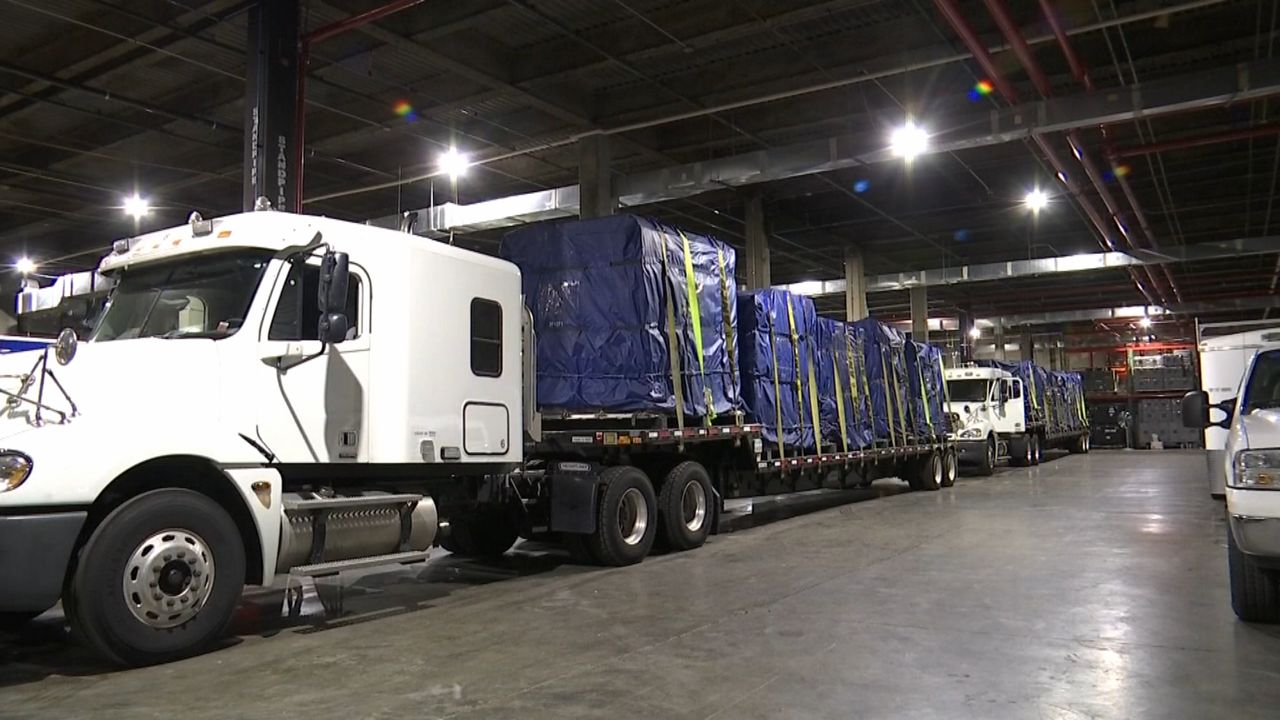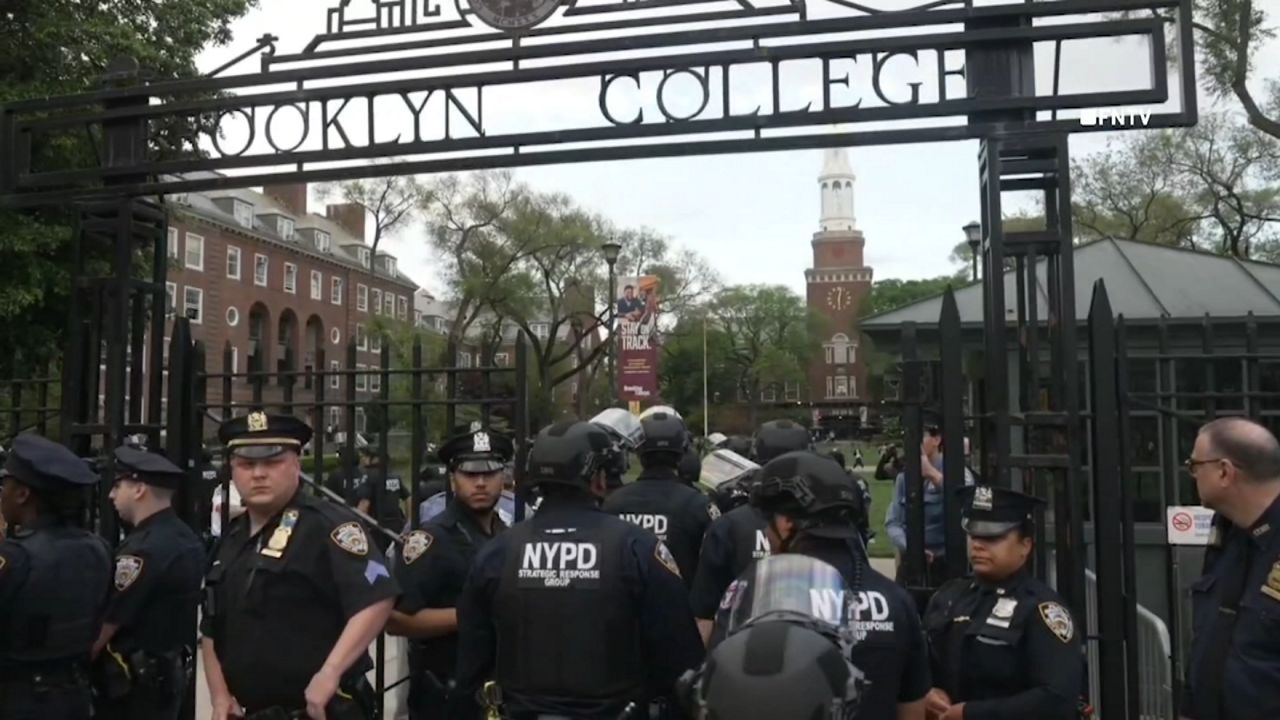New York City emergency responders were deployed to Florida on Friday night to help with preparations as Hurricane Dorian became a Category 4 storm.
MEMBERS OF THE NYPD AND FDNY HEAD TO FLORIDA
47 members of the Urban Search and Rescue New York Task Force 1 left from their Brooklyn facility for Jacksonville on Friday night in response to a request from FEMA.
The team is made up of NYPD and FDNY members with specialized training in disaster relief recovery, two K-9s, and a New York City Emergency Management coordinator. Emergency Management said it will bring 13 vehicles, box trucks, vans, and other equipment to Florida. The team hopes to arrive in Jacksonville by noon Saturday.
The team said its exact tasks weren't confirmed Friday night, as it would need to adapt based on the storm, but it will bring equipment to assist in search and rescue and providing medical assistance.
"Whatever they ask of us, we will be able to meet their needs," said FDNY Chief Jack Flatley, the task force's leader.
Gov. Andrew Cuomo is also sending an incident management team, which is slated to arrive Sunday.
ANY IMPACT ON NEW YORK'S WEATHER?
Dorian isn't forecast to significantly impact New York City, with dry conditions and temperatures in the 70s and 80s expected this weekend. It's unclear if the city will feel the fringe effects of Dorian on Monday as it heads out to sea; that will depend on the storm's track.
- WEATHER BLOG: Defining, Understanding the "Cone"
- TRACKING THE TROPICS: Get tropical updates, forecast models, satellite loops, and more
- STORM SEASON 2019: Latest headlines | Biggest hurricane myths debunked | Interactive storm tracker | Printable supply checklist | Tropical storm 2019 names
AN INTENSIFYING HURRICANE
As of 11 p.m., Dorian was moving west-northwest at 10 miles per hour, with maximum sustained winds of 140 miles per hour.
It's the first Category 4 hurricane in the Atlantic in 2019. There have only been 18 category 4 or 5 hurricanes in the Atlantic in August since the beginning of the satellite era in 1966.
A Hurricane Warning is in effect for the Northwestern Bahamas except for Andros Island. A Hurricane Watch is in effect for Andros Island.
The storm quickly strengthened in the past few hours; it wasn't forecast to become this powerful until Sunday. Of concern: there is nothing slowing the storm down from intensifying further.
Hurricane Dorian powered toward Florida with increasing fury Friday, becoming an "extremely dangerous" Category 4 storm but leaving forecasters uncertain whether it would make a direct hit on the state's east coast or inflict a glancing blow.
Dorian will continue to move northwest, then west over warm waters. Low wind shear will likely continue, so intensification is still possible.
Small storms like this one are subject to rapid intensification, so quick changes in wind speed are possible.
The models are in good agreement for the next couple of days, moving Dorian west over the Northern Bahamas.
Dorian will likely make a fairly sharp turn north close to or over Florida due to an expected weakness in a ridge of high pressure just north of the storm. The models diverge as they approach the Florida Coast.
But this afternoon, models are shifting east of their previous runs. Some have it making landfall in Southeast Florida, some as far north as Melbourne, and some show it staying in the Atlantic skirting the coast and moving north.
The timing of it nearing Florida's east coast also varies, from Monday to Tuesday. The coastal areas of Georgia, South Carolina, and North Carolina may be at risk if Dorian does not make landfall in Florida.
The size of the storm is small, so where it goes will affect the local forecast dramatically.
If it does make landfall in Florida, it will likely be a big rainfall producer. The models do agree on slowing it down by that point, so flooding rains will be the biggest hazard after a landfall.
But the location of the storm will affect rain totals, too. There will be much less rain on the west and southwest side of the center. Very heavy rain will fall on the east to northeast side.
For Tampa Bay, storm surge is not expected. Heavy rain is likely, though.
Tropical storm force winds are possible. Polk County may see stronger winds, though.
Florida's east coast will have much stronger effects, with hurricane force winds and possible storm surge. The strongest effects will be where the center makes landfall (if it does) and just to the north. Flooding rains are very likely.
None of these effects will start until Monday at the earliest. This forecast is likely going to fluctuate considerably until then.
There are fears Dorian could prove to be the most powerful hurricane to hit Florida's east coast in nearly 30 years.
President Donald Trump declared a state of emergency in Florida and authorized the Federal Emergency Management Agency to coordinate disaster-relief efforts.
Millions of people could be in the crosshairs, along with Walt Disney World and Trump's Mar-a-Lago resort.
As Dorian closed in, it upended people's Labor Day weekend plans. Major airlines began allowing travelers to change their reservations without a fee. The big cruise lines began rerouting their ships. Disney World and the other resorts in Orlando found themselves in the storm's projected path.
Still, with Dorian days away and its track uncertain, Disney and other major resorts held off announcing any closings, and Florida authorities ordered no immediate mass evacuations.
"Sometimes if you evacuate too soon, you may evacuate into the path of the storm if it changes," Gov. Ron DeSantis said.
As of 8:30 p.m. EDT, Dorian was centered about 575 miles (925 kilometers) east of West Palm Beach with winds of 130 mph (215 kph). It was moving northwest at an ever-slower 10 mph (17 kph). Forecasters warned that its slow movement could subject the state to a prolonged and destructive pummeling from wind, storm surge and heavy rain.
Coastal areas could get 6 to 12 inches (15 to 30 centimeters) of rain, with 18 inches (46 centimeters) in some places, triggering life-threatening flash floods, the hurricane center said. FEMA official Jeff Byard said Dorian is likely to "create a lot of havoc" for roads, power and other infrastructure.
Also imperiled were the Bahamas, where canned food and bottled water were disappearing quickly and the sound of hammering echoed across the islands as people boarded up their homes. Dorian was expected to hit by Sunday with the potential for life-threatening storm surge that could raise water levels 15 feet above normal.
"Do not be foolish and try to brave out this hurricane," Prime Minister Hubert Minnis said. "The price you may pay for not evacuating is your life."
In Florida, the governor urged nursing homes to take precautions to prevent tragedies like the one during Hurricane Irma two years ago, when the storm knocked out the air conditioning at a facility in Hollywood and 12 patients died in the sweltering heat. Four employees of the home were charged with manslaughter earlier this week.
DeSantis said the timely message from those arrests is: "It's your responsibility to make sure you have a plan in place to protect those folks."
At NASA's Kennedy Space Center in Cape Canaveral, NASA moved a 380-foot-high mobile launch platform to the safety of the colossal Vehicle Assembly Building, built to withstand 125 mph (200 kph) wind. The launcher is for the mega rocket that NASA is developing to take astronauts to the moon.
The hurricane season typically peaks between mid-August and late October. One of the most powerful storms ever to hit the U.S. was on Labor Day 1935. The unnamed Category 5 hurricane crashed ashore along Florida's Gulf Coast on Sept. 2. It was blamed for over 400 deaths.
------
Information from the Associated Press was used in this report.








_Pkg_Car_Stolen_with_Child_Inside_Clean_FOR_APPROVAL_134114017_565)